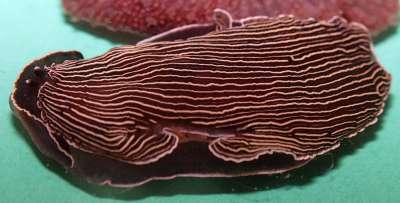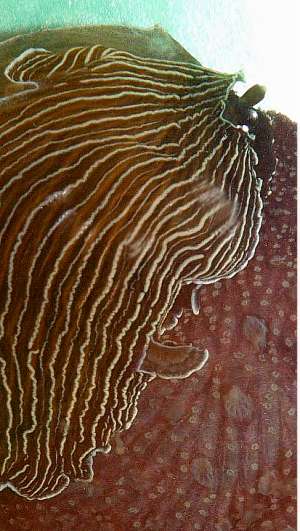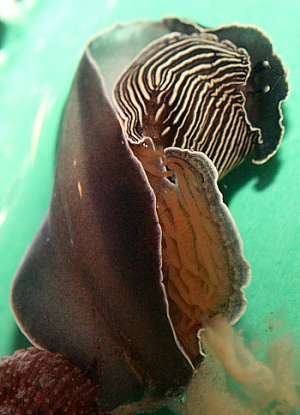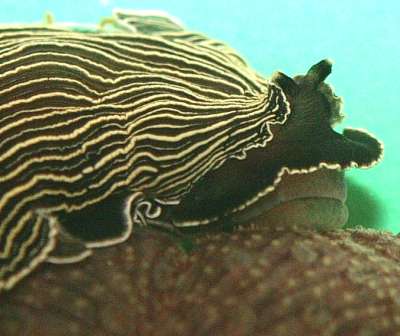Armina abbotti from NW Florida
March 10, 2004
From: Kelly Hooper

Hi Bill,
I have another nudibranch that I need some help identifying from Apalachicola Bay, northwestern Florida. The only thing I can find that looks remotely close is Hypselodoris edenticulata but it seems the link is mostly in color and not morphology. I have yet to see any rhinophores or cerata. It has one pair of small eyes. They look like eyes at least. The gills seem to be along either side under the mantle.. It is a real dark maroon with thin yellow stripes. It loves to eat sea pansies (Renilla spp - see lower left photo). They get pretty large, more than two inches. I am attaching four pictures. I have its eggs but during the transfer to get the picture they lost their form so I didn't send any pictures of them. I again appreciate all your knowledge and help.
Thanks,
Kelly Hooper
kelly.hooper@fwc.state.fl.us



Dear Kelly,
This is apparently a fairly common nudibranch in soft-bottom subtidal environments in the southeastern USA. It has usually been identified as the Mediterranean species Armina tigrina, but Thompson et al (1990), while reviewing Mediterranean arminids, named it Armina abbotti after Tucker Abbott who published an early account of its biology. A much fuller account was later published by Eyster (1981) from animals studied in South Carolina. I was intersted in your mention of it feeding on Renilla. Most species of Armina feed on sea pens [order Pennatulacea] or the related sea pansies such as Renilla. The Californian species Armina californica is reported to cause a spectacular 'light show' when it feeds on the bioluminescent species Renilla koellikeri.
The anatomy of arminds is a bit different from the aeolids and dorids you are more familiar with. I have included a close-up alongside of the head, where you can see the two little rhinophores [they are black with white tips]. It's hard to see here, but in most arminids the rhinophores have a few vertical lamellae rather than the horizontal or transverse lamellae found in many dorids. Have a look at the rhinophore page for some examples. Concerning gills. On the underside of the mantle skirt you will find two types of folds or lamellae. As you can see in the lower left photo, the posterior two-thirds of the underside of the mantle has brownish longitudinally arranged folds, which contain branches of the digestive gland. These are called hyponotal lamellae or lateral lamellae but unfortunately the names of these structures differ from publication to publication. In front of these hyponotal lamellae, there is a transverse band of more delicate lamellae on each side, running from the side of the body out to the mantle edge. These are considered to be the gills [branchial lamellae]. Have a look at the Fact Sheet for Armina juliana for a photo of the underside of an arminid.
• Abbott, R.T. (1954) The habits and occurrence of the nudibranch Armina tigrina in southeast United States. The Nautilus, 67(3): 83-86
• Bertsch, H (1968) Effect of feeding by Armina californica on the bioluminescence of Renilla koellikeri. The Veliger, 10(4): 440-441.
• Eyster, L.S. (1981) Observations on the growth, reproduction and feeding of the nudibranch Armina tigrina. J. Moll. Stud., 47: 171-181.
• Thompson, T.E., Cattaneo, R. & Wong, Y.M. (1990) Eastern Mediterranean opisthobranchia: Dotidae (Dendronotoidea), Arminidae and Madrellidae (Arminoidea). J. Moll. Stud., 56: 393-413.
Related messages
-
Armina from the Gulf of Mexico
From: Gary Gray, June 22, 2007
